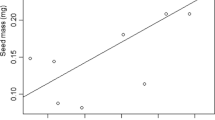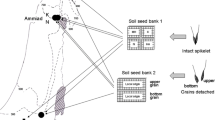Abstract
In species with seeds losing viability shortly after dispersal and exhibiting inherently low germination, quick decisions are required with respect to seeds that should be selected to maximize germination success and vigorous growth of seedlings. In ‘hollong’ (Dipterocarpus macrocarpus Vesque), I address the following questions: (a) are seeds that germinate randomly distributed within a seed population, (b) are subpopulations of viable and non-viable seeds separable, (c) does seed size predict which seeds germinate and (d) does seed size predict time required for germination and seedling vigour? Two estimators of seed size, diameter and weight, demonstrated a significant positive linear relationship endorsing assumption that accumulation of mass increases with increase in diameter of seeds. A threshold for selection of potential seeds for germination could not be derived from diameter measurements since seeds in an entire range of diameter did or did not germinate. All seeds <11 g did not germinate, but this threshold lies at the far lower end of the weight range and allows rejection of only a few seeds and acceptance of many seeds that will not germinate. A risk of potential seeds being rejected or non-viable seeds being picked exists if selection was derived from either diameter or weight. However, viable seeds could be better predicted from a scatter-plot of diameter on x-axis and weight on y-axis. Seeds showed a fan-shaped scatter and those developing the lower blade of the fan did not germinate while those following the handle were successful. Hence, two subpopulations segregated, but with a fuzzy edge. Mean diameter and mean weight of germinated seeds were significantly greater than those of ungerminated seeds. Most ungerminated seeds were those that had relatively smaller weight compared to their diameter. Although some large diameter seeds with small weight did germinate, but failed to develop into seedlings. Germination time and seedling vigour parameters (height, leaf number and collar diameter) were correlated both with diameter and weight. However, weight appears to have mattered more than diameter in germination success and early seedling growth.
Similar content being viewed by others
References
R.C. Barnard (1956) ArticleTitleRecruitmentsurvival and growth of timber tree seedlings in natural tropical rain forest Malay. For. 19 156–161
R.N. De (1940) Nursery and Plantation Notes for Assam Assam Government Press Shillong, India
S.A. Foster (1986) ArticleTitleOn the adaptive value of large seeds for tropical moist forest trees: a review and synthesis Bot. Rev. 52 260–299
W.J. Garrison C.K. Augspurger (1983) ArticleTitleDouble- and single-seeded acorns of bur oak (Quercus macrocarpa): frequency and some ecological consequences Bull. Torrey Bot. Club 110 151–160
K.L. Gross (1984) ArticleTitleEffect of seed and growth from a seedling establishment of six monocarpic parental plants J. Ecol. 72 369–387
P.J. Grubb (1977) ArticleTitleThe maintenance of species richness in plant communities: the importance of the regeneration niche Biol. Rev. 52 107–145
A.R. Hoshmand (1998) Statistical Methods for Environmental and Agricultural Sciences EditionNumber2 CRC Press New York
H.F. Howe E.W. Schupp L.C. Westley (1985) ArticleTitleEarly consequences of seed dispersal for a neotropical tree (Virola surinamensis) Ecology 66 781–789
M.L. Khan Shankar Uma (2001) ArticleTitleEffect of seed weightlight regime and substratum microsite on seed germination, and seedling growth of Quercus semiserrata Roxb Trop. Ecol. 42 117–125
M.L. Khan P. Bhuyan Shankar Uma N.P. Todaria (1999) ArticleTitleSeed germination and seedling fitness in Mesua ferrea L. in relation to fruit size and seed number per fruit Acta Oecol. 20 599–606 Occurrence Handle10.1016/S1146-609X(99)00101-0
M.A. McGinley D.H. Temme M.A. Geber (1987) ArticleTitleParental investment in offspring in variable environments: theoretical and empirical considerations Am. Nat. 130 370–398 Occurrence Handle10.1086/284716
Mohan Lal K.B. 1960. Manipulation of undergrowth for aiding natural regeneration of evergreen and semi-evergreen forests. Proceedings of the All-India Tropical Moist Evergreen Forest Study Tour and Symposium, Forest Research Institute, Dehra Dun.
F.S.P. Ng (1978) Strategies of establishment in Malayan forest trees P.B. Tomlinson M.H. Zimmermann (Eds) Tropical Trees as Living Systems Cambridge University Press Cambridge, UK 129–162
H. Paz S.J. Mazer M. Martinez-Ramos (1999) ArticleTitleSeed mass, seedling emergenceand environmental factors in seven rainforest Psychotria (Rubiaceae) Ecology 80 1594–1606
Rajkhowa S. 1960a. Assam valley semi-evergreen forests and their regeneration. Proceedings of the All-India Tropical Moist Evergreen Forest Study Tour and Symposium, F.R.I, Dehra Dun.
Rajkhowa S. 1960b. Forest types of Assam with special reference to the evergreen and semi-evergreen forests. Proceedings of the All-India Tropical Moist Evergreen Forest Study Tour and Symposium, F.R.I, Dehra Dun.
S. Rajkhowa (1961) ArticleTitleThe Upper Assam Dipterocarpus-Mesua forests and their regeneration Indian For. 87 IssueID7 406–425
P.W. Richards (1957) The tropical rainforest: an ecological study University Press Cambridge, UK
Roy S.B. and Kalyan Naha 1967. Hollong – its past and present. Proc. X Silva. Conf., Dehra Dun, Manager of Publications, Delhi.
Sen Gupta J.N. 1939. Dipterocarpus (gurjan) forests in India and their regeneration. Indian Forest Records 3(4), N.S., Silviculture Manager of Publications, Delhi.
S.K. Seth S.N. Dabral (1960a) ArticleTitleCharacteristic features of natural regeneration under various tending schedules in Hollong-Nahor (Dipterocarpus-Mesua) forest of Assam Indian For. 86 IssueID6 355–373
Seth S.K. and Dabral S.N. 1960b. Standard volume tables for Dipterocarpus macrocarpus Vesque. Indian Forest Records 10(9), N.S., Silviculture, Manager of Publications, Delhi.
Srinivasan M.M. 1956. Working plan for the Lakhimpur Forest Division, Assam (1st October1949 to 30th September1959). Department of Forests, Assam.
InstitutionalAuthorNameStatSoft Inc. (1995) STATISTICA for Windows (Computer Program Manual) TulsaOK, StatSoftInc USA
R.S. Tripathi M.L. Khan (1990) ArticleTitleEffect of seed weight and microsite characteristics on germination and seedling fitness in two species of Quercus in a subtropical wet hill forest Oikos 57 287–296
R.S. Troup (1980) The Silviculture of Indian Trees Forest Research Institute Dehra Dun
L.A. Turnbull M. Rees M.J. Crawley (1999) ArticleTitleSeed mass and the competition/colonization trade-off: a sowing experiment J. Ecol. 87 899–912 Occurrence Handle10.1046/j.1365-2745.1999.00405.x
R. Uma Shaanker K.N. Ganeshaiah K.S. Bawa (1988) ArticleTitleParent-offspring conflictsibling rivalry and brood size pattern in plants Ann. Rev. Ecol. Syst. 19 177–205
Vincent A.J. 1961. A note on the growth of eleven individual species of the genus Dipterocarpus (Keruing) in naturally and artificially regenerated forest Malaya. Research Pamphlet No. 28, F.R.I. Federation of Malaya.
T.C. Whitmore (1975) Tropical Rain Forests of the Far East Clarendon Press Oxford
J.H. Zar (1984) Biostatistical Analysis Prentice-Hall, Inc. New Jersey
Author information
Authors and Affiliations
Corresponding author
Rights and permissions
About this article
Cite this article
Shankar, U. Seed Size as a Predictor of Germination Success and Early Seedling Growth in ‘Hollong’ (Dipterocarpus macrocarpus Vesque). New Forest 31, 305–320 (2006). https://doi.org/10.1007/s11056-005-8198-6
Received:
Accepted:
Issue Date:
DOI: https://doi.org/10.1007/s11056-005-8198-6




